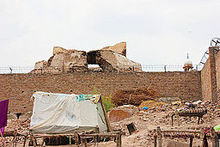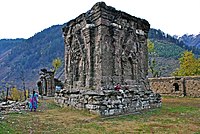Prahladpuri Temple, Multan
| Prahladpuri Temple پرَہْلادْپُورِی مندر | |
|---|---|
 Ruins of Prahladpuri Temple | |
| Religion | |
| Affiliation | Hinduism |
| District | Multan |
| Deity | Prahlada |
| Festivals | Holi |
| Governing body | Pakistan Hindu Council |
| Location | |
| Location | Multan |
| Country | |
 Shown within Punjab, Pakistan | |
| Geographic coordinates | 30°12′01.3″N 71°28′36.6″E / 30.200361°N 71.476833°ECoordinates: 30°12′01.3″N 71°28′36.6″E / 30.200361°N 71.476833°E |
| Architecture | |
| Type | Hindu temple |
| Website | |
| http://www.pakistanhinducouncil.org/ | |
Prahladpuri Temple (Urdu: پرَہْلادْپُورِی مندر) was a Hindu temple located in Multan city of Punjab province in Pakistan, adjacent to the Shrine of Bahauddin Zakariya. Named after Prahlada, it is dedicated to the Hindu deity Narasimha.
The temple is presently in ruins, since its destruction in 1992 by a Muslim mob in retaliation for the demolition of the Babri Masjid in Ayodhya, India and the site is currently owned by Evacuee Trust Property Board.[1][2]
Location[]
It is located on top of a raised platform in the southern tip of the Fort of Multan, adjacent to tomb of Baha’ul Haq Zakariya.[2]
Mythology[]

In Hindu mythology, the original temple is said to have been built by Prahlada, son of Hiranyakashipu, the Asur-king of Multan[a] in honor of Narsing Avatar, an incarnation of Hindu deity Vishnu who saved his life.[2] It is the place where the Lord Narasimha is said to have appeared out of pillar to save him from his father.[3] The Hindus, therefore, believe the festival of Holika Dahan to have started here.[1]
History[]
The current temple (now, in ruins) were constructed in the colonial spans on the ruins of pre-Muslim structures of unknown origin and use.[2] The temple was supposedly built on the ruins of an earlier sanctuary of the Sun God, which having housed a golden statue embellished with jewels, was frequently mentioned by multiple travelers to Multan (Xuanzang, 614 AD etc.)[4]
There were older temples on the site which were constructed and razed multiple times or successively refurbished in the medieval era but the precise details are hazy in light of conflicting chronicles.[2]
Oral legends hold that a temple used to exist around the 15th century before being razed by Sher Shah Suri to construct a mosque.[2] The original temple was a columnar structure and both the roof and the columns supporting it were made of pure gold.[2] The new temple was constructed, when this mosque fell down.[2] However, that Jean de Thévenot mentions of a temple at the site during his visit in 1665, the mosque must have been put to disuse within about a century of its construction which is highly unlikely given its royal patronage.[2]
In 1810, the height of the temple was significantly raised (rebuilt - ?), which apparently led to tensions with the Muslim community.[5][2] Alexander Burnes, during his visit in 1831, noted the temple to be a building of low height, supported by wooden pillars and having Hanuman and Ganesha as the guardians to its portal; he was denied entrance.[2][6] It was also remarked to be the only place of Hindu worship in Multan.[2][6] An annual festival used to be held in the premises on the anniversary of Narasimha's appearance.[7]
During the 1848 Siege of Multan, a shell fired by forces of East India Company fell on gunpowder store within the fort and caused havoc; the roof of the temple was blown away.[7][8] During a visit in 1854, Alexander Cunningham noted the temple to be a roofless "square brick building with some very finely carved wooden pillars", and the only Hindu shrine in Multan alongside Suraj Kund.[2][7] Post-siege, the East India Company retained control of the fort and all adjoining areas (incl. shrines) for some years before returning them back to native communities, upon a petition.[2] A condition was imposed in August, 1852 to the effect of disallowing Hindus to approach the temple via precincts of Zakariya's shrine in lieu of being allowed to refurbish the temple.[2] In 1859, another mutual agreement was undertaken by both communities to not incorporate conspicuous additions to either site.[2]
In 1861, the Chief Mahant of the temple, Baba Ram Das raised about Rs.11,000 by way of public donation and refurbished the temple.[2] However, in the early 1870s, then-Chief Mahant, Baba Narayan Das proposed to raise the height of the temple-spire to 44 ft, which was more than that of the adjoining shrine, with donations from Thakur Dawara Fateh Chand Tanksalia and other Hindu citizens.[2] This was opposed by local Muslims in what was deemed to be a breach of the 1859-agreement, and led to an acrimonious dispute.[2] The local administration intervened and the issue was decided in favor of the Muslims; an agrement was enacted on 14 April, 1876 to restrict the height to 33 ft.[2]
However, the dispute simmered in the background and gradually morphed into a full-blown communal crisis.[9] On 20 September 1881, a communal riot erupted, resulting in 50,000 rupees worth of damage; no lives were lost.[9][10] Hindu rioters burned a mosque in the city's bazaar, attacked the Walli Muhammadi Mosque, and burned a Quran.[11] A Muslim mob retaliated about 2 hours later, arsoning the temple.[11] The entire contingent of British troops from Multan Cantonment had to be dispatched to control the mobs.[10]
Soon afterwards, the temple was renovated with funds raised by the Hindu community, and continued to be managed by the community.[12]
Post Independence status[]
After the creation of Pakistan, most Hindus migrated to the newly independent Republic of India but the affairs of temple continued to be managed by the remaining Hindus[1] of city. A madrasa was soon established inside the temple.[13][14]
The building continued to be a prominent landmark in Multan, having a main hall, circumlocutory and skylights, and a large mandapa.[2] The central hall even had a replica of idol under a baldachin.[2] A dharamshala complex was also created adjacent to temple.[2]
Destruction and aftermath[]
In 1992, the temple (as well as the dharamshala complex) was destroyed by a Muslim mob in retaliation for the destruction of Babri Masjid in Ayodhya, India; local Hindus associated with the temple were also targeted.[1][2] It has been in ruins ever since; the lower levels has been occupied by squatters, garbage is regularly dumped in the site, and there has been a risk of total collapse of the structures, which still stand.[2]
In 2006, on occasion of Urs of Baha-ud-din Zakariya, the minister of government, ordered construction of facilities for Wuzu and in 2008 facilities for Langar in premises of temple. These actions were later protested by some NGOs as according to the Constitution of Pakistan, no Muslim construction can be done within the places of worship of other religions. A case was filed and court ordered stay on construction. The matter is still pending in court. Many peaceful protests were held by minority organizations and many persons and organizations have requested Government of Pakistan to restore this ancient temple of importance.[1]
Reconstruction[]
In December 2020, a one-man commission was established by the Supreme Court of Pakistan to interrogate into the status of minority religious shrines and ETPB's maintenance.[15] The report was submitted in February, urging for the immediate restoration of Prahladpuri Temple along with three other temples (a bevy of policy-changes were proposed as well); accordingly, Chief Justice of Pakistan Gulzar Ahmed ordered the state of Punjab and ETPB to ensure optimum preparedness of the shrine for Holi festival.[15][16][17] Soon afterwards, the Multan government and local bodies announced plans to restore the temple as part of a broader project at ensuring religious harmony.[18][19][20][21]
Notes[]
See also[]
- Multan Sun Temple
- Hinduism in Pakistan
- Evacuee Trust Property Board
- Mankiala stupa
- Hinglaj Mata
- Kalat Kali Temple
- Katasraj temple
- Multan Sun Temple
- Sadh Belo
- Shivaharkaray
- Shiv Mandir, Umerkot
- Shri Varun Dev Mandir
- Tilla Jogian
References[]
- ^ Jump up to: a b c d e "Archived copy". Archived from the original on 2013-12-11. Retrieved 2012-04-10.CS1 maint: archived copy as title (link)
- ^ Jump up to: a b c d e f g h i j k l m n o p q r s t u v w x y "Archived copy". Archived from the original on 2015-01-07. Retrieved 2015-01-07.CS1 maint: archived copy as title (link) Survey & Studies for Conservation of Historical Monuments of Multan. Department of Archeology & Museums, Ministry of Culture, Government of Pakistan
- ^ Maclagan, Edward (1926). Punjab District Gazetteers: Multan District 1923-24. VII. The Superintendent Government, Lahore. pp. 276–77.
- ^ Suvorava, Anna (2004). "The Spiritual Sovereign of Multan". Muslim Saints of South Asia: The Eleventh to Fifteenth Centuries. London: Routledge. p. 153. doi:10.4324/9780203592717-8. ISBN 9780203592717.
- ^ Punjab (India) (1976). Extracts from the District & States Gazetteers of the Punjab, Pakistan: Punjab (Pakistan). Research Society of Pakistan, University of the Punjab.
- ^ Jump up to: a b Burnes, Alexander (1834). "Chapter V". Travels into Bokhara. 3. London: John Murray, Albemarle Street. pp. 115–116.
- ^ Jump up to: a b c Cunnngham, Alexander (1875). ARCHAEOLOGICAL SURVEY OF INDIA VOL.5. The Superintendent of Government, Calcutta. pp. 126, 129.
- ^ Monuments of Multan Archived 2016-02-01 at the Wayback Machine Survey & Studies for Conservation of Historical Monuments of Multan. Department of Archaeology & Museums, Ministry of Culture, Government of Pakistan
- ^ Jump up to: a b Roseberry, J. Royal (1987). Imperial Rule in Punjab: The Conquest and Administration of Multan, 1818-1881. Manohar. ISBN 978-81-85054-28-5.
- ^ Jump up to: a b Ross, David (1883). The Land of the Five Rivers and Sindh: Sketches Historical and Descriptive. Chapman and Hall, limited. p. 100.
prahladpuri temple riot -1992 -babri.
- ^ Jump up to: a b Proceedings - Punjab History Conference. Publication Bureau, Punjabi University. 2000. ISBN 9788173807220.
- ^ AIR 131 (Lahore High Court 1923).
- ^ Khalid, Haroon. "Both colour and memories of Holi have faded from Pakistan's Multan, where the festival was born". Scroll.in. Retrieved 2021-02-22.
- ^ Khalid, Haroon. "These temples in Pakistan are now madrasas". Scroll.in. Retrieved 2021-02-22.
- ^ Jump up to: a b Mohan, Geeta (February 8, 2021). "Pakistan: Most Hindu worshipping places in country neglected, says SC-appointed commission". India Today. Retrieved 2021-02-22.
- ^ "Pakistan SC Orders Immediate Reconstruction of Vandalised Hindu Temple". The Wire. Retrieved 2021-02-22.
- ^ Reporter, The Newspaper's Staff (2021-01-05). "Commission suggests opening of four temples for tourism". dawn.com. Retrieved 2021-02-22.
- ^ https://www.sci.gov.in/pdf/JUD_2.pdf
- ^ Qureshi, Raiq (2021-02-15). "Multan peace committee takes multiple initiatives for restoration of Holi-origin Prahladpuri temple". Associated Press Of Pakistan. Retrieved 2021-02-22.
- ^ Reporter, The Newspaper's Staff (2021-02-13). "Hindu council to host festivities at Parlhad Mandir next month". dawn.com. Retrieved 2021-02-22.
- ^ Ali, Muhammad (2021-02-16). "A view of ruins of ancient Prahladpuri Temple. The restoration work on ancient Prahladpuri temple is likely to commence in next few days. Holi, the festival of colours, very much popular in Hindus, commenced from this Prahladpuri temple. The temple is located near the shrine of great saint of sub-continent Hazrat Bahauddin Zakariya RA". Associated Press Of Pakistan. Retrieved 2021-02-22.
External links[]
- Hindu temples in Punjab, Pakistan
- Destroyed temples
- Hindu pilgrimage sites in Pakistan
- Buildings and structures in Multan
- Buildings and structures demolished in 1992



